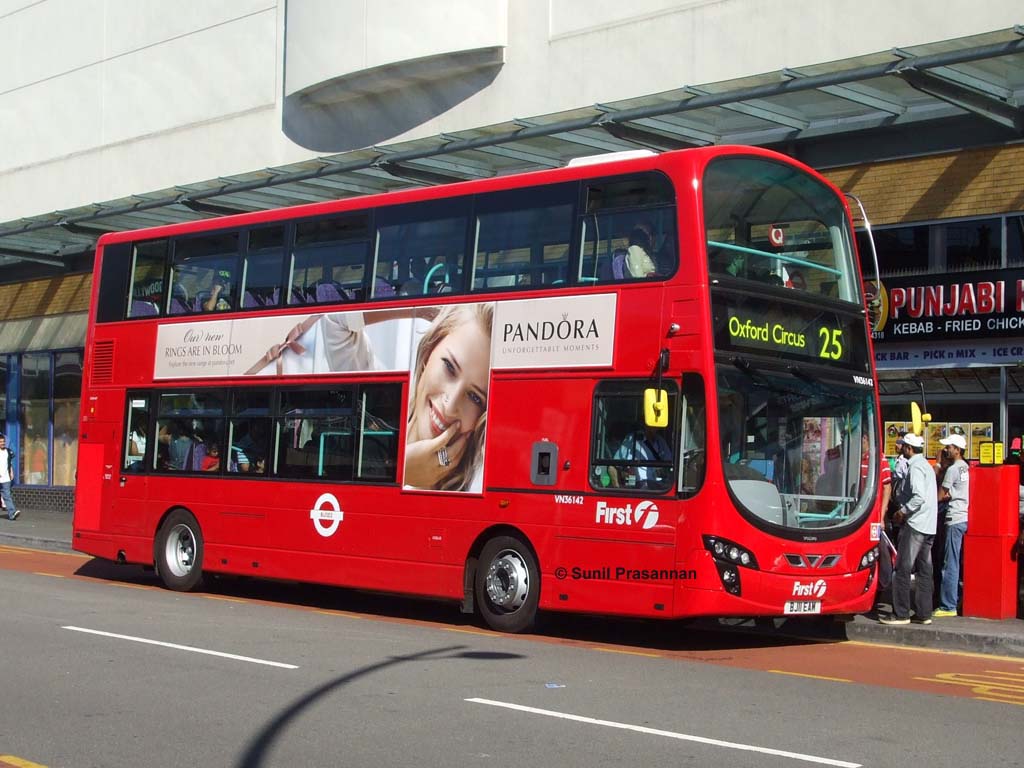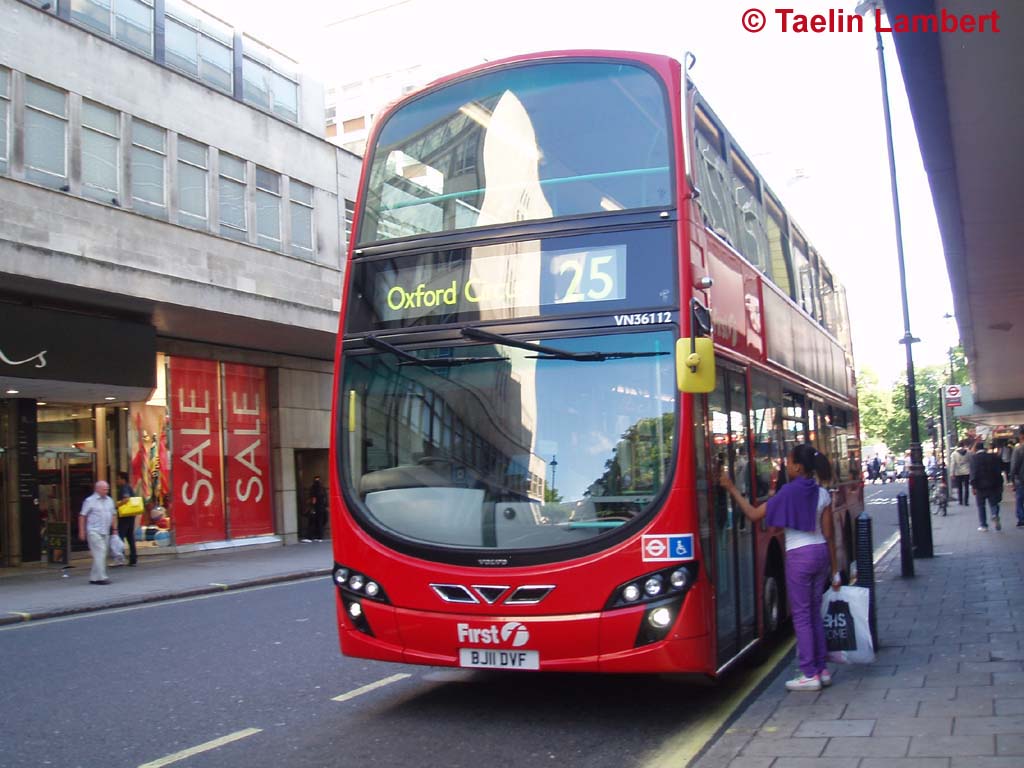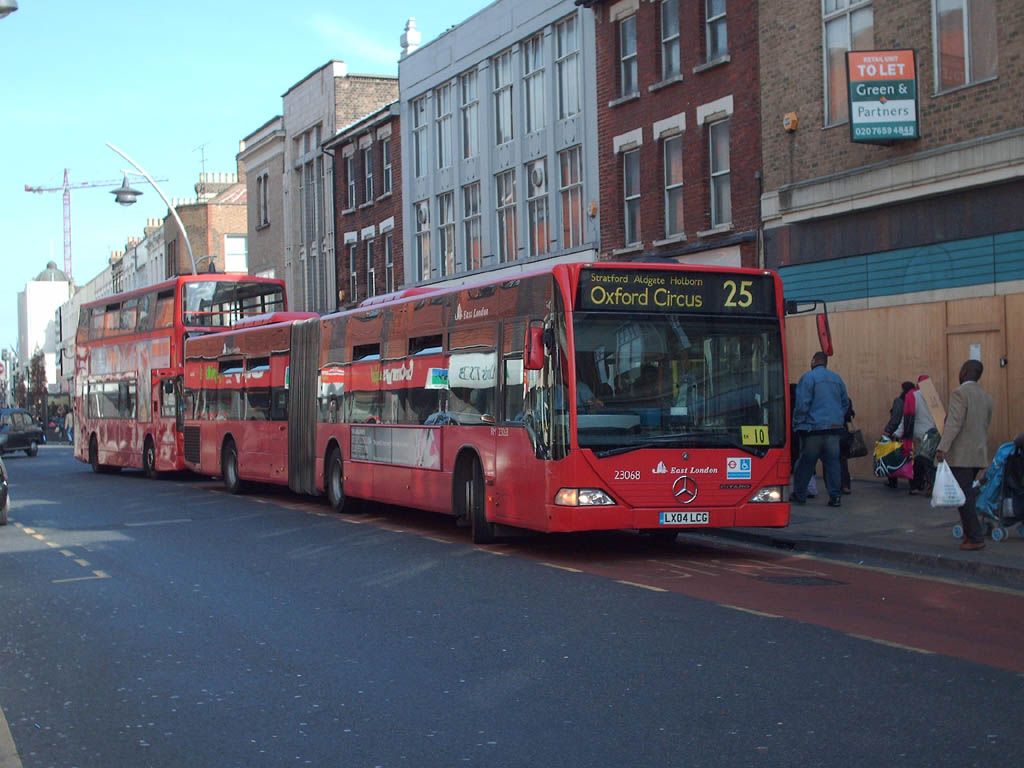 | Photo © Sunil Prasannan. |
Home | Bus routes | Operational details | Service changes | Operators & Garages | Photo gallery
The 25 has had an extraordinary tendering history, having changed operator each of the last three occasions it has been tendered – although only two operators have been involved! The route is now back with First Capital for a second stint, and has reverted to double deck operation from articulated single deckers. First ordered Wright bodied Volvo B9TLs, and two views are provided here. First is VN36142 (BJ11 EAM) in Clements Road, Ilford, on the second day, 26 June 2011. Note the traditional London Transport roundel, making a re-appearance after an absence of many years from the bus fleet.
 | Photo © Sunil Prasannan. |
The second photograph shows sister vehicle VN36112 (BJ11 DVF) on the very first day, 25 June 2011, right at the other end of the route, at the stand in Holles Street, Oxford Circus, sandwiched between John Lewis and BHS. The hopeful passenger may have become accustomed to artic operations, where it was quite common for buses to let passengers on before departure time. One significant change is that the 25 can now take a much more direct route from the stand eastwards, turning via Cavendish Place and Great Portland Street missing out the most congested part of Oxford Street. Artics were unable to use this route owing to tight turns, and had to stick to the traditional route departing via Vere Street.
 | Photo © Taelin Lambert. |
It is not often that major routes change operator, as the sheer scale of the task of finding perhaps 100 extra drivers to cover a route of over 30 buses makes this extremely difficult, so it is quite remarkable that the 25 has changed hands each of the last three times it has been tendered – each time it has set a new record for the largest route to do so. Traditionally a Bow route, the first change of operator was to Capital Citybus on 26 June 1999.
The first few months of First operation saw use of second-hand MCW Metrobuses, somewhat intrusive in a part of London which traditionally was firmly Titan territory. New short wheelbase Dennis Tridents were introduced as soon as possible; however, these new double deck low floor buses seated just 59, owing to very generous legroom provision. This led to extreme overcrowding; the buses had replaced 79-seat Volvo Olympians used by Stagecoach with no real change to frequencies! These early Tridents were quickly replaced with long wheelbase examples when the opportunity arose for cascades (first to routes 97/357, then 191), but that was not enough to solve the capacity issues.
The introduction of congestion charging saw a new schedule introduced with a hefty service increase to a requirement for 40 buses, up from 30 when Capital had taken it on. This may have helped in the short term, but buses soon filled up again! Re-tendering again in 2004 brought the predictable and then-fashionable response of converting the route to articulated single deckers. These have a much higher theoretical capacity than double deckers, with around 140 passenger spaces rather than 90, although most of this is standing room rather than seated and it is questionable if it can be achieved in practice.
At that point it was awarded back to Stagecoach East London with the aforementioned artics; PVR reduced slightly to 37 as a result of withdrawing three PM peak journeys, but again set a record for the largest route to change hands. The route inaugurated Stagecoach's new Waterden Road garage as an operational base, having previously been used for storage. There were three bus garages in Waterden Road; First called theirs Hackney, while Stagecoach had two on opposite sides of the road. The original one was called Stratford and went back to London Buses days when it was opened to take on midibus work from Bow garage. All three were within the Olympics construction area, and had to close by the end of 2007.
A weekend routeing variation via Tower Hill instead of Bank was also withdrawn from the start of the new contract. However, even the larger artics started leaving people behind – one theory is that, because they operate on an “open boarding” principle where the only means of revenue protection is random (and seemingly infrequent) checks, passengers were deserting the parallel District and Central Lines for the 25 and the prospect of a free ride. Either way it became necessary to introduce a further frequency increase, taking the PVR to 42, at the expense of route 453, which was reduced. This took effect from 14 February 2005.
The service had to be diverted eastbound from 2 June 2008 after City of London council noticed that the artics were illegally exceeding a weight restriction in the Aldgate area. To avoid the restriction buses had to run via Monument and Tower Hill, leaving the normal direct route via Cornhill unserved in that direction. It was initially hoped that this would be a short-term arrangement until the restriction could be lifted or modified, but City refused to oblige until such time as it could repair the weak bridge. So a revised timetable was introduced with extra running time, increasing the PVR to 44.
During Crossrail construction works for the new Tottenham Court Road station from 16 January 2010 the route had to be curtailed to there, as the artics could not follow the diversion followed by other routes. This rather called into question whether the route needed to serve Oxford Circus at all, with the PVR cut by 5 buses to 39 illustrating the potential savings, but it was nonetheless restored from 6 November the same year.
Meanwhile the bridge works at Aldgate were completed on 14 May 2011, with just six weeks of artic operation remaining! The diversion via Tower Hill therefore ended, but the extra bus was however retained in the schedule up to the end, as it was still subject to two separate and unrelated diversions in the Cheapside and Cornhill areas; these finished soon after the contract changed hands.
Then as mentioned above the route was awarded back to First Capital from 25 June 2011 (later, route 26 and 30 were also awarded from Stagecoach to First from the same date, creating quite a shockwave through the East London bus industry). The new mayor is phasing out the artics and the new structure was deemed to need an incredible 59 new double deckers! The contract was awarded earlier than usual, leaving plenty of time to get buses and drivers organised. Recruitment is less of a problem these days, and indeed often outgoing operators transfer the existing drivers with the contract to avoid having a surplus, although this does create uncertainty for the new contractor. The new service pattern incorporates short workings to Holborn Circus, rather than all buses doing the full route.
The 25, unsurprisingly, has a long history. The traditional route was from Victoria via New Bond Street to Oxford Circus, then the present route via Bank, Aldgate, Stratford to Ilford, then variously on to Seven Kings (25), Barkingside (25A) or Becontree Heath (25B). There was also the 25C, which diverted at Manor Park to East Ham, while the 25B was extended beyond Victoria Station to Ebury Bridge. Each route ran every 6 minutes on Mondays to Fridays, providing an incredible 40 buses per hour on the common sections; something like 150 buses must have been allocated, and the routes were operated from garages in Seven Kings, Forest Gate, Upton Park and (oddly) Hammersmith (Riverside) on the 25.
Various parts have fallen by the wayside over the years, the 25B variant from Victoria to Becontree Heath eventually becoming the main service and losing its suffix in about 1950. By 1982 the route was running in two overlapping sections, Victoria to Ilford and Aldgate to Becontree Heath; in that year the latter section was renumbered 225, albeit running to Limehouse instead of Aldgate. Both routes were Routemaster operated, but the 225 was soon converted to one-person operation using Titans – no doubt the original reason for the split. The 225 also reverted to Aldgate at this time to match loadings. In 1988, the 25 (now Victoria to Ilford) was also converted to one-person operation, and consequently the 225 was renumbered back to 25 to match. The combined 25 was operated from Bow garage and needed no fewer than 60 Leyland Titans! The weekend diversion via Tower was also introduced at this time.
The first real cutbacks to this very long route did not come until 1992, when the Victoria to Oxford Circus section was handed over to route 8. The sections were retained however, with Seven Kings garage now operating Becontree Heath to Aldgate and Bow from Ilford to Oxford Circus. In March 1993 a local route scheme saw the 25 cut back to Ilford with a straight through service; new route 128, with the 129, covered the section to Becontree Heath.
However, this did give a reduced service between Ilford and Aldgate, leading to the very heavy loadings that have persisted to this day, especially between Stratford and Aldgate where the 25 was the only route until very recently (the 205 extension provides a substantial boost). Capital Citybus, in their 1999 bid, proposed a reversion to sectional operation during the day on Mondays to Saturdays, with the sections being Ilford to Aldgate and Stratford to Oxford Circus. This very sensible suggestion was turned down on the grounds of service simplification! The inner section would have been operated by the above mentioned Hackney garage, with the outer section operating from Dagenham (some way off route!) – in the event the whole route went to Dagenham.
This base was moved to Rainham, and Rainham's inability to accommodate the long artics was cited as a reason for the route reverting to Stagecoach operation, though I would have thought a base in Hackney would be more economical anyway. An interesting coincidence is that First gave Rainham the code R, which was also the code for Hammersmith Riverside garage, which, as mentioned above, had an allocation on the 25 at one time!
I was asked to retain the photo of East London Citaro artic 23068 (LX04 LCG) in Ilford High Road on 5 March 2008 just starting the long journey to Oxford Circus. Notable is that the bus is carrying the RM garage code and RM10 running number card from the route's temporary allocation at Rainham garage: this only lasted a few months, from 29/12/07 to 18/04/08 inclusive, as its previous Waterden Road garage had been closed (it is now buried beneath the Olympic Park) but the replacement garage at West Ham was not yet ready.
 | Photo © Suzy Scott. |
Navigation
| Previous | Next | |
| Chronologically | 105 | 73 |
| Numerically | 24 | 27 |
Photo Gallery | Bus route list | Operational details | Service changes | Operators & Garages